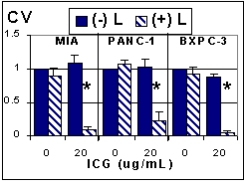# 105704 Abstract ID: 105704 Laser Activation of Indocyanine Green Induces Dose-dependent Cytotoxicity in Multiple Human Pancreatic Cancer Cell Lines
William W Tseng, Romaine E Saxton, Carson D Liu, Chicago, IL; Los Angeles, CA
Indocyanine green (ICG) is a water-soluble, FDA-approved dye used in medical diagnosis. When activated by an infrared laser in the presence of oxygen, ICG generates reactive singlet oxygen. Infrared laser offers the advantage of deeper tissue penetration thus making it suitable for treatment of solid, intra-abdominal cancers such as pancreatic adenocarcinoma. PURPOSE: To determine cytotoxicity of infrared 808 nm laser light in human pancreatic cancer cells containing ICG. METHODS: Three human pancreatic adenocarcinoma cell lines, MIA PaCa-2, PANC-1, and BxPC-3 were incubated for 1 hr at 37 C with ICG at dosages ranging from 0 to 50 ug/mL. Cells were thoroughly washed to remove unbound dye, then briefly exposed to 808 nm light from a diode laser at 450 mW. MTT cell viability assays were performed at 72 hrs post-treatment. Studies were repeated in quadruplicate and statistical analyses were done using a Student's t-test. RESULTS: Dark toxicity was not seen in MIA PaCa-2 or PANC-1 cells at any ICG dosage. Slight toxicity was seen at 50 ug/mL ICG in BxPC-3 cells. No toxicity was seen with laser light alone in any of the cells lines. For all three cell lines, cell viability (CV) assays at 72 hrs showed an ICG dose-dependent ablation when combined with laser exposure (+L). Significant inhibition of growth was seen at 10 ug/mL ICG+L with nearly total ablation at 20 ug/mL ICG+L. (*p<0.01) CONCLUSIONS: Infrared laser activation of ICG induces consistent pancreatic cancer cell death in a dose-dependent manner. Since neither ICG nor laser alone caused significant toxicity, combination therapy may offer effective control of tumor growth with minimal side effects in patients with primary and metastatic pancreatic cancer.

|
 500 Cummings Center
500 Cummings Center +1 978-927-8330
+1 978-927-8330
 +1 978-524-0461
+1 978-524-0461